
This happens to be the seventh edition of summaries of various abstracts prepared by students that I taught in class this past winter semester. This year, I had three students in a special horticultural research class (abstracts 1-3) focused on plant nutrition issues, and 10 students in a greenhouse production class, where the students focused more on environmental aspects of production. The first group had individual projects, while the second group worked in pairs.
This happens to be the seventh edition of summaries of various abstracts prepared by students that I taught in class this past winter semester. This year, I had three students in a special horticultural research class (abstracts 1-3) focused on plant nutrition issues, and 10 students in a greenhouse production class, where the students focused more on environmental aspects of production. The first group had individual projects, while the second group worked in pairs.
These were third- or fourth-year students working towards a bachelor’s of science in agriculture (B.Sc. Agr.) degree. The topics the students worked on came mostly from suggestions I had picked up during the past few years, although some students came up with their own projects.
It has to be realized that these studies were started and finished within a 10-week growing period, so the results are from one trial only. There was not enough time for replications. This means that the results presented in the abstracts should be judged with the foregoing in mind. It provides an overview of the type of projects the students had pursued. The following eight abstracts are from the 2009 winter semester.
EFFECTS OF COCO COIR EXTRACT ON CUCUMBER GROWTH
By Jacob Yantzi
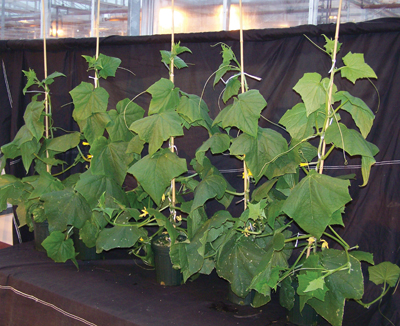
|
|
| FIGURE 1. Representative cucumbers after seven weeks grown in granulated rockwool and irrigated with different concentrations of coco coir extract in the nutrient solution. Concentrations of extract (from left to right) were 100 per cent, 75 per cent, 50 per cent, 25 per cent coco coir extract, and 0 per cent control. All treatments were provided with a complete nutrient solution (Hoagland), with adjustments for background levels in the coco coir. |
Some people claim that coco coir as a growing medium increases cucumber growth and yield compared to rockwool. The aim of this study was to show that the chemical components of the coco coir (cq. humic acids) is responsible for this effect.
In order to determine this hypothesis, an extract was made by soaking coco coir in DI water and collecting the filtrate. Chemical analyses of the inorganic nutrients in the extract were then done. Then nutrient solutions were made with the extract as well as a standard Hoagland solution using DI water with compensation for the sodium and chloride concentrations in the coco coir extract.
Five solutions were prepared with 0, 25, 50, 75 and 100 per cent coco coir extract by mixing the two original solutions. Cucumbers were grown in granulated rockwool and watered with one of the five solutions.
The results showed that cucumbers grown in the 100 per cent coco coir treatment were marginally shorter than either the 75 per cent, 50 per cent, 25 per cent or 0 per cent (control) (FIGURE 1). However, the different coco coir concentrations did not affect the fresh or dry matter accumulation of cucumber plants.
THE EFFECT OF SUBSTRATE VOLUME ON GROWTH AND DEVELOPMENT OF TWO POTTING PLANTS – MARIGOLDS (TAGETES ERECTA) AND SALVIA (SALVIA SPLENDENS)
By Louise Milton
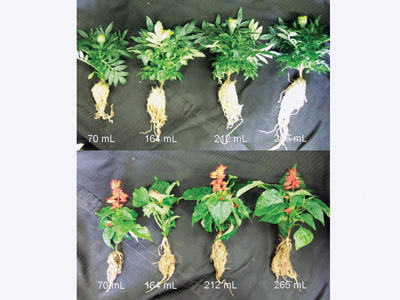
|
|
| FIGURE 2. The effect of rooting volume of growth of marigolds and salvia.
|
The effect of substrate volume on two bedding plants marigolds (Tagetes erecta) and salvia (Salvia splendens) was studied over a 10-week period to evaluate the relationship between cell size and plant growth and development.
Seedlings were transplanted into four different cell sizes (70, 164, 212 and 265 ml) and plants were subirrigated using capillary matting. Measurements were taken over a three-week harvest period looking at leaf area, dry weight, plant height and width. It was noted that substrate volume affected plant growth (and development?) of both bedding plants species. Leaf area and dry weight for shoot and root increased over the harvest period.
Smaller substrate volumes resulted in restricted roots that impaired root absorption, reduced nutrient uptake, and resulted in smaller plants. Larger substrate volumes showed increased leaf area and dry weights of plants, and increased lateral branching (FIGURE 2). Flowering did not seem to be affected. Water stress was controlled as all cells had the same height and the watering mat provided moisture to all pot sizes.
BORON CONCENTRATIONS AFFECTING NUTRIENT UPTAKE IN SUNFLOWER (Helianthus annus, L)
By Carson Tiede
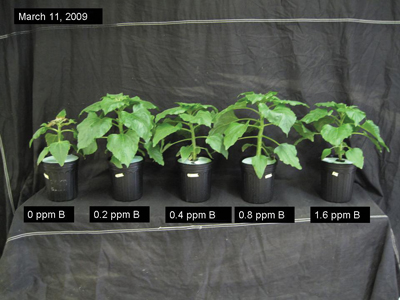
|
|
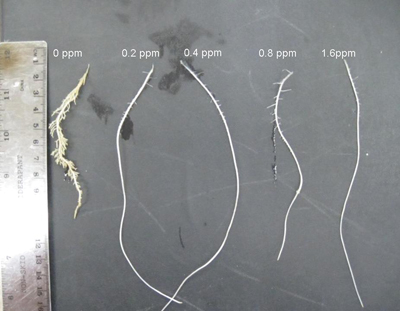
|
|
| FIGURE 3. Comparison of plants height and root growth of sun flowers grown hydroponically with different boron concentrations (left to right, 0, 0.2, 0.4, 0.8, 1.6 ppm B). Pictures taken on March 11, 2009. |
There is limited information on boron affecting the uptake of other nutrients. This experiment was aimed to confirm if any nutrients are affected by changing boron concentrations.
Sunflowers were grown in containers with a complete nutrient (Hoagland) solution and with boron concentrations varying from 0, 0.2, 0.4, 0.8 and 1.6 ppm, respectively. Plants grown in the solution without boron experienced boron deficiency 47 days after seeding (FIGURE 3). Also, lateral roots were formed and the roots became yellowish in colour, while chlorosis/necrosis occurred in the growing point of plants. Tissue analyses of the aerial portion of the plants indicated that there were no synergistic or antagonistic effects from boron on the uptake of the other 11 nutrients in solution.
EFFECT OF LIGHT INTENSITY OF A LIGHT SOURCE WITH A LOW R:FR RATIO ON THE HEIGHT OF EASTER LILIES
By George Austin and Jeremy Boychyn
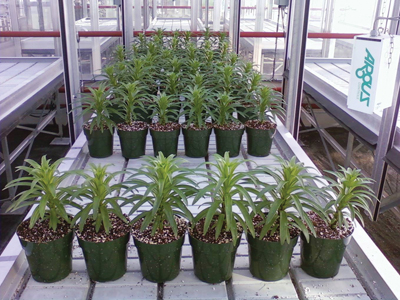
|
|
| FIGURE 4. The layout of the bench with the Easter lilies placed at different light intensities. The (twilight) light source was placed directly above the front row. |
End-of-day light quality (~twilight) has been shown to increase the height of Easter lilies. The light quality during the twilight period changes from about 1.0 to 0.7 over a period of 20 to 30 minutes.
In our experiment, we wanted to determine whether the intensity of the light during the twilight period would affect plant elongation. Easter lilies were placed on two benches with blackout screens when they were 15-cm tall. One bench had a light source with a light quality similar to twilight (R/FR~0.7) at one end of the bench, while the other bench did not have any light (control).
On the first bench, rows with equal light intensities were marked out (1.45, 0.8, 0.4, 0.2, 0.1, 0.02 and 0.01 µmol/m2/sec) with six plants placed at each intensity (FIGURE 4).
Both benches were exposed to full daylight with the blackout curtains closed 20 minutes before twilight, and opened 20 minutes after sunrise to prevent any natural twilight reaching the lilies. Lilies were exposed daily to 20 minutes of artificial twilight after the blackout closed at the end of the day.
Initially, the far-red light produced little to no effect, but as the season progressed with more daytime sunlight exposure, the effects of the far-red light began to appear. No correlation was found between plant height and the light intensity from the incandescent bulb. It is important to note that the experiment ran between January and April, as the low, and gradually increasing day light intensity may have had a significant impact on the results.
THE EFFECT OF WATER AND AIR TEMPERATURE ON THE EFFECTIVENESS OF PACLOBUTRAZOL APPLIED VIA FOLIAR SPRAY IN HEIGHT CONTROL OF PETUNIA GRANDIFLORA AND IMPATIENS WALLERIANA
By Luyang Zhong and Melody de Jong
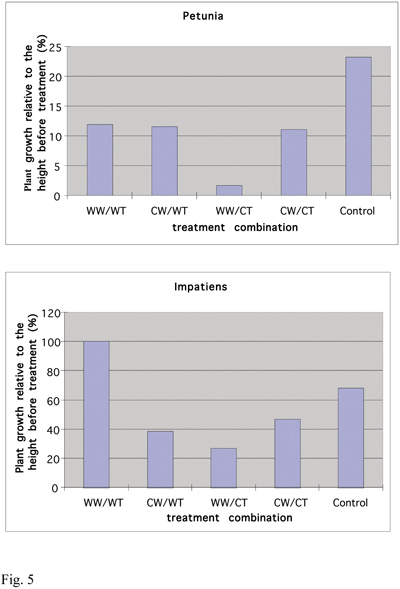
|
|
| FIGURE 5. The effect of air temperature (WT and CT) and solution temperature of the Bonzi solution (WW and CW) on plant height of petunias and impatiens. |
Bonzi (a.i. paclobutrazol) is a plant growth retardant widely used in the ornamental industry to keep bedding plants within a marketable target height. In our experiment, the response of petunia (Petunia grandiflora) and impatiens (Impatiens walleriana) to a single Bonzi spray at 4 ppm was evaluated to investigate the effects of water and air temperature on the effectiveness of Bonzi in height control. Bonzi spray solution was applied under four conditions, which were warm water (25°C)/cold air (15°C), cold water (6°C)/cold air (15°C), warm water (25°C)/warm air (26°C) and cold water (6°C)/warm air (26°C), and plants not treated with Bonzi were served as the control (warm air). It was found that the plants from both petunia and impatiens had a greater height control when Bonzi was applied under cool air with a warm solution temperature for both petunias and impatiens (FIGURE 5).
THE EFFECT OF CONTAINER (VOLUME) SIZE ON ROOTING OF SUPERTUNIA AND NEW GUINEA IMPATIENS VEGETATIVE CUTTINGS
By Haq Imtiazul
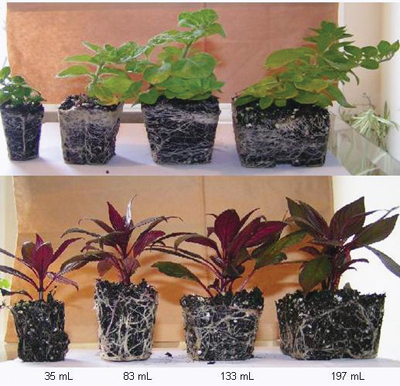
|
|
| Figure 6. Unrooted cuttings of Supertunia and New Guinea impatiens in different cell volumes after about nine weeks.
|
Different container sizes alter the root volume of the plant, which may affect plant growth and/or development. In general, seedlings produce smaller plants with smaller leaves when grown in smaller compartments. In order to check whether the hypothesis also applies to rooted cuttings, the following was done. Vegetative cuttings of Supertunia and New Guinea impatiens were stuck in cells of four different volumes, namely 35, 83, 133 and 197 ml and filled with Sungrow #1. Rooting took place in a mist bed using deionized water only. After rooting, all cells were provided with 10 ml of fertilizer solution containing 20-8-20, while plants remained in the misting area with a reduced frequency. Results showed that plant height, shoot dry weight, leaf area and leaf weight of both Supertunia and New Guinea impatiens plants increased linearly with container size (FIGURE 6).
THE EFFECTS OF FOUR DIFFERENT MEDIA ON THE VEGETATIVE GROWTH OF CHRYSANTHEMUMS USING SUBIRRIGATION AND DRIP IRRIGATION TREATMENTS
By Wesley Cook
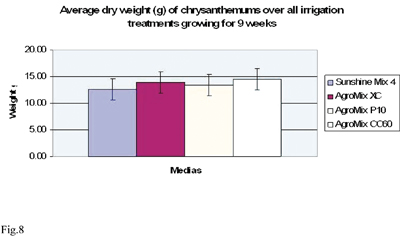
|
|
| FIGURE 7. The effect of four different substrate of the dry weight of chrysanthemums. The data show the mean over two irrigation systems and two irrigation frequencies. |
Chrysanthemum cuttings potted in four different media (Sunshine Mix 4, AgroMix XC, AgroMix P10 and AgroMix CC60) equally distributed to four different irrigation treatments – subirrigated daily (i) or every three days (ii), drip irrigated daily (iii) or every three days (iv) – identifying whether there are differences in plant growth productivity of the four media. There was an attempt to provide the same volume of water to every pot. Data was collected on the vegetative growth of the cuttings after nine weeks of being under long days.
The following growth parameters were collected: height (cm), root rating (scale 1-5), fresh and dry weight. Based on the results of these parameters, there was no statistical evidence of significant differences between the four media, when the results were averaged over irrigation type and frequency (FIGURE 7).
Interestingly, drip irrigation showed a 10 per cent increase in fresh weight over subirrigation, while daily irrigation showed a 30 per cent increase compared to irrigating every three days. It was observed that with subirrigation, the roots tended to be extremely dense near the bottom of the pot, while with drip irrigation the roots were more uniformly distributed throughout the pot.
EFFECTS OF LIGHT QUALITY ON GERMINATION AND EARLY DEVELOPMENT OF VARIOUS BEDDING PLANT SPECIES
By Jourdan Tregunno and Chris Voorberg
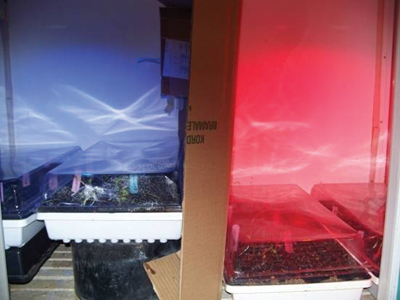
|
|
| FIGURE 8. The setup of the growth chambers with blue and red LEDs. The seedling trays under the blue LEDs were raised in order to obtain similar light intensities. |
Plants tend to respond quite distinctively to different light qualities. This experiment was done to examine whether red and blue light-emitting diodes (LEDs) would affect germination of different plant species.
Six different plant species were seeded in plug trays and placed in a 25°C growth chamber, which was provided with blue LEDs on one side and red LEDs on the other (FIGURE 8). Photoperiod was 12 hours and irradiance was 12 µmol / m2/ sec for both sides. There were two types of control treatments: (i) in a greenhouse under ambient conditions, and (ii) a dark control.
Observations were taken over 17 days. Differences between red and blue LEDs were not noted in either the rate of germination or total germination, but LED lighting significantly increased shoot length in comparison to the ambient light control. In fact, the two LED treatments showed the same shoot lengthening characteristics as the dark control treatment.
Print this page